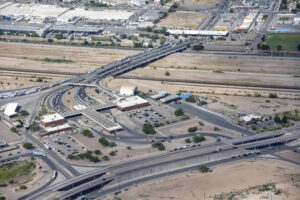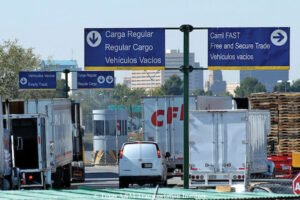 Development of Direct Cost Estimation (DCET-SE) Dashboard
Development of Direct Cost Estimation (DCET-SE) Dashboard
Efficient border crossings are vital for the global economy, but delays due to infrastructure limitations, security checks and congestion can lead to significant economic costs. To quantify these costs, CIITR developed the Direct Cost Estimation Tool (DCET) in 2011, which was updated through 2018 for northbound commercial motor vehicle (CMV) crossings. In 2020, the tool was expanded into DCET-SE to include privately owned vehicles (POV) and southbound CMV crossings. A case study at the Ysleta-Zaragoza Bridge in El Paso showed that southbound CMV crossings accounted for 17–20 percent of delay costs, while POV crossings contributed 13–20 percent. This highlights the importance of including various modes and directions in cost assessments.
For more information contact Okan Gurbuz at [email protected].
Feasibility Study for Level 3 AV at Border Crossing Phase II
As automated vehicle (AV) technology progresses, land border crossings present unique challenges. The development of AV applications for these crossings is lagging, which could leave vehicles with AV capabilities but without the necessary applications for border navigation. This project aims to develop a low-cost AV border crossing application using the comma.ai platform, which relies on vision sensors rather than costly sensors like those in Autoware. The study will document AV environment features such as lane striping, merging and traffic control at a border crossing in El Paso. This work builds on FY23 efforts where comma.ai hardware was successfully tested on highways and arterial streets.
For more information contact Swapnil Samant at [email protected].
 Pilot for Lane-Based POV Wait Time Measurement Technologies
Pilot for Lane-Based POV Wait Time Measurement Technologies
The US-Mexico border sees millions of vehicles crossing annually, leading to extended wait times. Current crossing time measurement technologies — which use Bluetooth and Wi-Fi — fail to differentiate between lane types (Standard, Ready and SENTRI). This project will pilot two technologies to address this: radio frequency identification (RFID) and video analytics using AI. RFID has already been successful for commercial vehicles and could now be used for passenger vehicles, especially given the Mexican government’s REPUVE tags. A limited test at Ysleta-Zaragoza showed promising results, and this project will extend the pilot to assess performance during peak and off-peak times, as well as test AI-based video analytics for tracking and counting vehicles.
For more information contact Swapnil Samant at [email protected].
 Development of a Bi-national DTA Model for El Paso/Juárez Region
Development of a Bi-national DTA Model for El Paso/Juárez Region
The El Paso-Ciudad Juárez border region has a complex transportation system with daily commuter and commercial traffic. Current models — like the El Paso Metropolitan Planning Organization’s (EPMPO’s) static travel demand model — fail to capture real-time dynamics such as vehicle queuing and congestion. This project proposes a dynamic traffic assignment (DTA) model that simulates congestion, accidents, work zones and dynamic tolling throughout the day. The model will build on the EPMPO’s existing bi-national model, offering a tool for local governments to analyze various scenarios, including work zones, incidents and extreme events. Phase I focuses on converting the existing model to DTA format and data collection, with Phase II (FY25) including traffic control and model validation.
For more information contact Jeff Shelton at [email protected].
 BorderFlow Analysis: Unveiling Cross-Border Dynamics in El Paso and Ciudad Juárez
BorderFlow Analysis: Unveiling Cross-Border Dynamics in El Paso and Ciudad Juárez
El Paso and Ciudad Juárez are interconnected by five Land Ports of Entry (LPOEs), facilitating regular cross-border travel. With the upcoming opening of the Tornillo LPOE for commercial vehicles, traffic patterns are expected to shift, potentially affecting other crossings. This study uses the latest INRIX data (Aug.–Oct. 2023) to analyze cross-border trips, comparing it to 2020 data, which was impacted by COVID-19 restrictions. The research aims to understand the influence of the new Tornillo crossing and to develop a decision-making model that highlights the factors influencing bridge selection by cross-border travelers. The findings will aid policymakers in understanding traffic dynamics and planning for future studies.
For more information contact Erik E. Vargas Rodriguez at [email protected].
 Environmental Cost of Delay at Border Crossing
Environmental Cost of Delay at Border Crossing
Delays at border crossings contribute to increased vehicle emissions, impacting air quality and public health. While past CIITR studies have focused on the economic cost of delays, this project seeks to quantify the environmental cost using El Paso as a case study. The research will use mobility and crowdsourced data to estimate delays and apply environmental impact analysis tools to assess emissions. As El Paso is a nonattainment area for air quality standards, understanding the environmental impact of delays is critical. The results will inform policymakers and contribute to future enhancements of the Direct Cost Estimation Tool, integrating environmental costs into cross-border studies.
For more information contact Madhusudhan Venugopal at [email protected].
 Framework to Analyze Traffic Flow at Commercial Ports of Entry
Framework to Analyze Traffic Flow at Commercial Ports of Entry
The El Paso region is a crucial gateway for U.S.-Mexico trade, with seven border crossings handling significant traffic from both pedestrians and motorized vehicles. The annual gross domestic product contribution from this movement is projected to grow from $91 billion to $356 billion by 2050. However, congestion and extended wait times — especially in El Paso County, which is in non-attainment for national air quality ambient standards — are pressing concerns. In response, TTI is collaborating with Customs and Border Protection (CBP) officials to develop a framework for analyzing cross-border traffic flow. This tool will simulate traffic at ports of entry, offering insights into infrastructure and operational improvements. The framework will allow CBP to explore various what-if scenarios — such as adding lanes or reducing inspection times — to optimize traffic flow during peak and off-peak periods. A case study in El Paso will demonstrate how this framework can inform CBP’s decisions and be applied to other ports.
For more information contact Jeff Shelton at [email protected].
 Exploring Cross-Border Truck Parking and Warehousing Issues
Exploring Cross-Border Truck Parking and Warehousing Issues
Land ports of entry (LPOEs) between the U.S. and Mexico are vital for trade, with nearly seven million trucks crossing in 2021. Truck parking — a major issue in the U.S. — also affects border crossings, particularly in urbanized areas like El Paso-Ciudad Juárez. This region hosts numerous industries on both sides of the border — including Mexican maquiladoras and suppliers — making efficient freight movement crucial. The lack of safe parking and warehousing impacts traffic congestion and wait times at LPOEs, which, in turn, affects the timely exchange of goods. This study explores the connection between truck parking, warehousing and border-crossing times using crowdsourced data and satellite imaging. By identifying correlations, the research aims to inform strategies to improve cross-border freight movement, reduce congestion and enhance economic ties between the U.S. and Mexico.
For more information contact Erik E. Vargas Rodriguez at [email protected].

